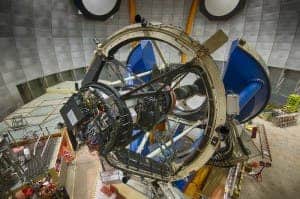Dark energy is the mysterious force that drives the Universe’s expansion at an ever increased pace. Probing and understanding this force is thus imperative for astronomers’ and cosmologists’ efforts of peering through the Universe’s secrets. Recently, a new massive project set on probing the nature of dark energy was launched, called the Dark Energy Survey (DES), and its future findings are already regarded in great promise.

DES’ centerpiece is its 570-megapixel digital camera (pictured), capable of imaging 300 million galaxies over one-eighth of the clear night sky from up atop the the 4-metre Blanco telescope at the Cerro Tololo Inter-American Observatory in the Chilean Andes. Galaxies and galaxy clusters are its main target since these are the brightest objects in the night’s sky and the camera’s high resolution capability can be most efficient. You see, to probe dark energy, the astronomers will measure weak gravitational lensing – the phenomenon in which incoming light from distant galaxies is skewed and distorted by matter between the galaxies and the point of observation (Earth).
Although measuring weak lensing is difficult, the researchers are confident this can be achieved. How is this important? Well, by measuring the degree of lensing, astronomers can infer and map the matter in between galaxies and Earth. This allow them in turn to create a three-dimensional web that can reveal the fingerprints of dark energy through time. A similar effort to DES has already been operation for quite a while – the Japanese Hyper Suprime-Cam in Hawaii, which relies on an even more detailed, 870-megapixel camera. Although Hyper Suprime can image fainter galaxies, DES can cover a wider patch of the sky. Together, the researchers hope these two projects will help paint a more accurate picture.
Besides weak lensing, DES will also be used to count galaxy clusters and measure their distance away from Earth, and spot distant supernovae, whose otherwise reference light is dimmed as the universe expands. The latter are of great importance since this is how the theory of an accelerating Universe was formed, netting the authors of the paper a Nobel prize in 2011.






